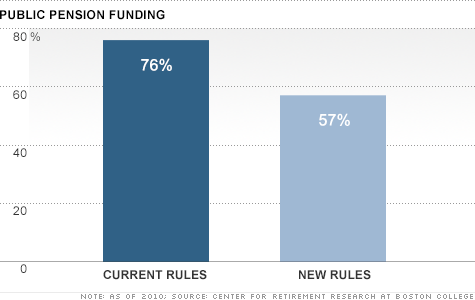
New rules require states and municipalities to disclose more information on public pension finances, prompting calls for reform.
NEW YORK (CNNMoney) -- States and cities will soon have to reveal just how big their pension holes are ... and that disclosure is likely to prompt more calls to reform public pension plans.
The Governmental Accounting Standards Board on Monday approved new laws that require governments to disclose their unfunded pension liabilities for the first time.
Currently, states and municipalities report how much they're supposed to contribute to their pensions each year -- and the amount they actually do. But until now, they didn't reveal their total pension obligation and how much they've socked away to cover it.
The new standards will provide "a clearer picture of the size and nature of the financial obligations to current and former employees," said Robert Attmore, GASB's chairman.
The new rules also change the accounting for pension assets and liabilities, in part by requiring states to value assets based on current market prices.
That accounting shift would have increased the funding gap in 2010 by $900 billion, according to estimates by the Center for Retirement Research at Boston College. State and local plans would only have been considered 57% funded -- how much in assets they have to cover their obligations -- rather than 76%.
"The numbers are going to look a lot worse," said Alicia Munnell, the center's director.
Some plans would have seen their funding levels plummet under the new rules. Illinois Teachers' pension would have dropped to 18.8%, down from 48.4%, according to the center. The funding ratio for New Jersey's public employees plan would have been cut nearly in half to 31.2%.
The overhaul, which takes effect in June 2014, does not change the health of the public pension plans and shouldn't result in many downgrades of state and local bond ratings.
But it is expected to increase pressure on governments to rein in pension costs.
"This is one element that will keep pension reform in the spotlight," said John Sugden, a director of U.S. public finance at Standard & Poors.
States and municipalities have struggled to fund their pension obligations for years. Some have repeatedly skipped payments or made minimal contributions, further worsening their financial situations.
But the Great Recession, and accompanying stock market plunge, left public pensions in an even more dire state. This prompted government officials to take some drastic actions.
Between 2009 and 2011, 43 states enacted benefit cuts, increased employee contributions or both, according to a recent report from the Pew Center on the States. They've increased the retirement age or years of services needed to qualify, limited the annual cost of living increase or changed the formula needed to calculate benefits to provide smaller checks.
Most of the changes apply to future retirees, though 10 states have frozen, eliminated or trimmed cost of living increases for current retirees. This has prompted legal challenges. Judges in Colorado and Minnesota have upheld the cuts, though the cases are still pending in other states. ![]()
| Overnight Avg Rate | Latest | Change | Last Week |
|---|---|---|---|
| 30 yr fixed | 3.80% | 3.88% | |
| 15 yr fixed | 3.20% | 3.23% | |
| 5/1 ARM | 3.84% | 3.88% | |
| 30 yr refi | 3.82% | 3.93% | |
| 15 yr refi | 3.20% | 3.23% |
Today's featured rates:
| Latest Report | Next Update |
|---|---|
| Home prices | Aug 28 |
| Consumer confidence | Aug 28 |
| GDP | Aug 29 |
| Manufacturing (ISM) | Sept 4 |
| Jobs | Sept 7 |
| Inflation (CPI) | Sept 14 |
| Retail sales | Sept 14 |